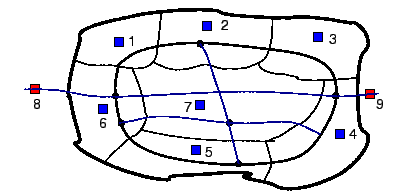Need of Zoning of land for OD Survey
While zoning of land for required survey, eg. OD survey the collected data will consist of a multitude of journey with different specific origins, destinations, purposes and modes which must be related to other traffic, sociological and economic factors. So, the defined study area is sub-divided into a number of small units called traffic analysis zones or simply zones. The sub-division into zones further helps in geographically associating the origin and destination of travel. Zones are modelled as if all their attributes and properties were concentrated in a single point called the zone centroid. The centroids are connected to the nearest road junction or rail station by the centroid connectors.
The zones within the study area are called internal zones and outside the study area are external zones.

The criterion for Zoning of land or division into the zones:
- With external traffic generators a whole country or state is zoned. For internal traffic within the city, the aim is to obtain zones of a similar generating size and also of a uniform traffic nature. Topographical features often form the main boundaries, with a further breakdown by land use and determining the sizes of individual zones.
- A compromise has often to be made on zonal homogeneity by selecting a predominant land-use activity.
- One criterion which determines a zone’s size is the capacity of its road network.
- The zones should not be too large to cause considerable errors in data. At the same time, they should not be too small either to cause difficulty in handling and analyzing data.
- The zones should preferably have regular geometric shape for easily determining the centroid.
- Sectors, natural or physical barriers such as canals, rivers, etc can form convenient zone boundaries.
- Zones must be compatible with screen lines and cordon lines.
- Zonal boundaries are determined by the transport network and act as a “watershed” of traffic generation enclosing the main public transport stops and corridor movements with the principal roads bisecting the zone.
Read about: Origin Destination Survey Methods